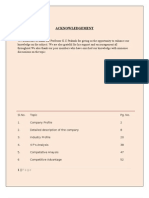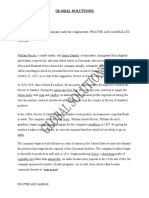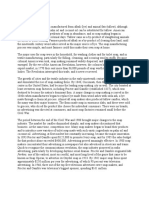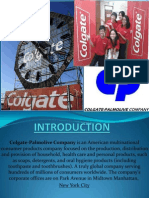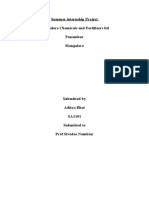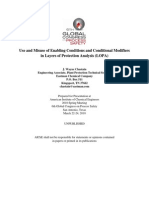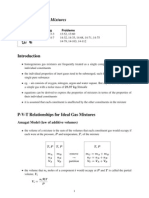History
History
Uploaded by
Abhi DhuriaCopyright:
Available Formats
History
History
Uploaded by
Abhi DhuriaOriginal Title
Copyright
Available Formats
Share this document
Did you find this document useful?
Is this content inappropriate?
Copyright:
Available Formats
History
History
Uploaded by
Abhi DhuriaCopyright:
Available Formats
history
In 1806, William Colgate, himself a soap and candle maker, opened up a starch, soap and candle
factory on Dutch Street in New York City under the name of "William Colgate & Company". In
the 1840s, the firm began selling individual cakes of soap in uniform weights. In 1857, William
Colgate died and the company was reorganized as "Colgate & Company" under the management
of Samuel Colgate, his son. In 1872, Colgate introduced Cashmere Bouquet, a perfumed soap. In
1873, the firm introduced its first toothpaste, an aromatic toothpaste sold in jars. His company
sold the first toothpaste in a tube, Colgate Ribbon Dental Cream, in 1896. In 1896, Colgate hired
Martin Ittner and under his direction founded one of the first applied research labs[4]. By 1908
they initiated mass selling of toothpaste in tubes. His other son, James Boorman Colgate, was a
primary trustee of Colgate University (formerly Madison University).
In Milwaukee, Wisconsin, the "B.J. Johnson Company" was making a soap entirely of palm and
olive oil, the formula of which was developed by B.J. Johnson in 1898. The soap was popular
enough to rename their company after it - "Palmolive".[5] At the turn of the century Palmolive,
which contained both palm and olive oils, was the world's best-selling soap, and extensive
advertising included The Palmolive Hour, a weekly radio concert program which began in 1927
and Palmolive Beauty Box Theater which ran from 1934 to 1937. A Kansas-based soap
manufacturer known as the "Peet Brothers" merged with Palmolive to become Palmolive-Peet. In
1928, Palmolive-Peet bought the Colgate Company to create the Colgate-Palmolive-Peet
Company. In 1953 "Peet" was dropped from the title, leaving only "Colgate-Palmolive
Company", the current name.
Colgate-Palmolive has long been in fierce competition with Procter & Gamble, the world's
largest soap and detergent maker. P&G introduced its Tide laundry detergent shortly after World
War II, and thousands of consumers turned from Colgate's soaps to the new product. Colgate lost
its number one place in the toothpaste market when P&G started putting fluoride in its
toothpaste. In the beginning of television, "Colgate-Palmolive" wished to compete with Procter
& Gamble as a sponsor of soap operas. Although the company sponsored many shows in part,
they fully sponsored the serial The Doctors.
George Henry Lesch was president, CEO, and chairman of the board of Colgate-Palmolive in the
1960s and 1970s, during that time transformed it into a modern company with major
restructuring.
In 2005, Colgate sold the under-performing brands Fab, Dynamo, Arctic Power, ABC, Cold
Power and Fresh Start, as well as the license of the Ajax brand for laundry detergents in the U.S.,
Canada and Puerto Rico, to Phoenix Brands, LLC as part of their plan to focus on their higher
margin oral, personal, and pet care products.[6]
In 2006, Colgate-Palmolive announced the intended acquisition of Tom's of Maine, a leading
maker of natural toothpaste, for US $100 million. Tom's of Maine was founded by Tom Chappell
in 1970.
Today, Colgate has numerous subsidiary organisations spanning 200 countries, but it is publicly
listed in only two, the United States and India.
In June 2007, counterfeit Colgate toothpaste imported from China was found to be contaminated
with diethylene glycol, and several people in eastern U.S. reported experiencing headaches and
pain after using the product.[7] The tainted products can be identified by the claim to be
manufactured in South Africa by Colgate-Palmolive South Africa LTD, they are 5oz/100ml
tubes (a size which Colgate does not sell in the United States) and the tubes/packaging contain
numerous misspellings on their labels. Colgate-Palmolive claims that they do not import their
products from South Africa into the United States or Canada and that DEG is never and was
never used in any of their products anywhere in the world. The counterfeit products were found
in smaller "mom and pop" stores, dollar stores and discount stores in at least four states.[8]
You might also like
- A Comparative Study On Consumer Behaviour About Colgate and Pepsodent PasteDocument49 pagesA Comparative Study On Consumer Behaviour About Colgate and Pepsodent PasteSuraj Dubey65% (17)
- Soap Making Business Startup: Start and Run a Successful Soap Making Business from HomeFrom EverandSoap Making Business Startup: Start and Run a Successful Soap Making Business from HomeRating: 4.5 out of 5 stars4.5/5 (5)
- Advances in Ethane CrackingDocument54 pagesAdvances in Ethane CrackingSaad Arif100% (2)
- Assignment On Product Life CycleDocument15 pagesAssignment On Product Life CycleRahul TambiNo ratings yet
- The ProcterDocument11 pagesThe ProctervaibhavpatsNo ratings yet
- P&GDocument85 pagesP&Gambujashok10% (2)
- ColgateDocument2 pagesColgateRithik TiwariNo ratings yet
- The Palmolive Hour: B.J. JohnsonDocument3 pagesThe Palmolive Hour: B.J. JohnsonAshlesh ShindeNo ratings yet
- Chapter 3 Profile of StudyDocument7 pagesChapter 3 Profile of Studyselwyn999No ratings yet
- Colgate HistoryDocument2 pagesColgate HistoryTommy LeónNo ratings yet
- History of ColgateDocument4 pagesHistory of ColgateSourabh JainNo ratings yet
- Marketing Strategy of Colgate (History)Document10 pagesMarketing Strategy of Colgate (History)Priyanka ShimpiNo ratings yet
- COLGATE HistoryDocument2 pagesCOLGATE HistoryHariom MhatreNo ratings yet
- Colgate Marketing ReportDocument16 pagesColgate Marketing ReportRaja GuruNo ratings yet
- ColgateDocument8 pagesColgatelaxmisunitaNo ratings yet
- Chapter1 IntroductionDocument20 pagesChapter1 Introductionselwyn999No ratings yet
- Colgate PalmoliveDocument10 pagesColgate PalmolivePriya Thakral100% (1)
- Graded Unit 2Document5 pagesGraded Unit 2Songyun Zhu0% (2)
- Company Profile: History of P&GDocument39 pagesCompany Profile: History of P&GMubeenNo ratings yet
- Colgate PalmoliveDocument12 pagesColgate PalmoliveCRAZY MINDNo ratings yet
- Public Nyse Cincinnati, Ohio USA A. G. Lafley Consumer Goods US$ US$Document13 pagesPublic Nyse Cincinnati, Ohio USA A. G. Lafley Consumer Goods US$ US$nad_sh31No ratings yet
- PNGDocument17 pagesPNGparachuritejaNo ratings yet
- Colgate ProjectDocument19 pagesColgate ProjectdhingrastoreNo ratings yet
- History: United Kingdom of Great Britain and IrelandDocument3 pagesHistory: United Kingdom of Great Britain and IrelandReyster CustodioNo ratings yet
- Procter & Gamble - History: Market Research Marketing Research Whitening ProductDocument3 pagesProcter & Gamble - History: Market Research Marketing Research Whitening ProductcutelakhsNo ratings yet
- Wiki P&GDocument9 pagesWiki P&Graj_mduNo ratings yet
- ColgateDocument40 pagesColgateVinayak Shinde100% (2)
- CSR P&GDocument38 pagesCSR P&GChristian Jay S. de la Cruz100% (1)
- Colgate-Palmolive CompanyDocument7 pagesColgate-Palmolive CompanyDanielle Clarice ReyesNo ratings yet
- History of OrganisationDocument3 pagesHistory of OrganisationSekar MuruganNo ratings yet
- History: Procter & Gamble (P&G) Is ADocument18 pagesHistory: Procter & Gamble (P&G) Is ARahul BhattNo ratings yet
- P&GDocument9 pagesP&GHe QingNo ratings yet
- My Company Is Subsidiary Company Under The ConglomerateDocument15 pagesMy Company Is Subsidiary Company Under The Conglomerateashley0902No ratings yet
- Company AnalysisDocument3 pagesCompany Analysisvrishali.bhandare1561No ratings yet
- The Product Lifecycle of ColgateDocument4 pagesThe Product Lifecycle of ColgateIgor BaciuNo ratings yet
- Perkins, One of The Earliest, Most Successful, and Most Long-Lived of The Genre That Came To BeDocument5 pagesPerkins, One of The Earliest, Most Successful, and Most Long-Lived of The Genre That Came To BeGlenn WatsonNo ratings yet
- C C C C CCC C CCCCCCCCCCCCCCCCC CC CCCCCCCCCCCCCCCCCCCCC C CDocument10 pagesC C C C CCC C CCCCCCCCCCCCCCCCC CC CCCCCCCCCCCCCCCCCCCCC C CVaibhav SinglaNo ratings yet
- Research Paper About Procter and Gamble CompanyDocument10 pagesResearch Paper About Procter and Gamble CompanyRafaiza Mano0% (1)
- Babe ProjectDocument37 pagesBabe ProjectOmkar PednekarNo ratings yet
- How Colgate, The Famous Minty Goop, Found Its Way Onto Your ToothbrushDocument3 pagesHow Colgate, The Famous Minty Goop, Found Its Way Onto Your ToothbrushnidaNo ratings yet
- Presentation On Colgate: By:Vaibhav Chaware Sub: IMCDocument28 pagesPresentation On Colgate: By:Vaibhav Chaware Sub: IMCVaibhav ChawareNo ratings yet
- Introduction of Colgate PalmoliveDocument12 pagesIntroduction of Colgate PalmoliveDilip SarojNo ratings yet
- Colgate PamoliveDocument21 pagesColgate Pamolivepayal22octNo ratings yet
- Public Company: Nyse PG Dow Jones Industrial Average ComponentDocument8 pagesPublic Company: Nyse PG Dow Jones Industrial Average ComponentMona SriNo ratings yet
- Touc Hin G Li Ves, Imp Ro Ving Life - Proc Ter & GambleDocument30 pagesTouc Hin G Li Ves, Imp Ro Ving Life - Proc Ter & Gamblechandni kundel75% (12)
- BORJA-Case Study-P&GDocument22 pagesBORJA-Case Study-P&Ghazelleborja17No ratings yet
- Colgate PalmoliveDocument1 pageColgate Palmoliveilimar2408No ratings yet
- P&GDocument34 pagesP&GShweta KediaNo ratings yet
- Strategic Management NEWWWWWWWWWWWDocument32 pagesStrategic Management NEWWWWWWWWWWWnadarkavita20No ratings yet
- Procter and GambleDocument8 pagesProcter and GambleVince EnriquezNo ratings yet
- FMCGDocument14 pagesFMCGDarsh TalatiNo ratings yet
- Prepared By: Rajesh ChaudharyDocument28 pagesPrepared By: Rajesh Chaudharytabzeel ahmadNo ratings yet
- Aniket Kamlesh Shubhangi VishwabhaktiDocument20 pagesAniket Kamlesh Shubhangi VishwabhaktiShubhangi PawarNo ratings yet
- Marketing Strategies of ColgateDocument19 pagesMarketing Strategies of Colgateshirley shekharan86% (14)
- Handmade Soap Book: Easy Soapmaking with Natural IngredientsFrom EverandHandmade Soap Book: Easy Soapmaking with Natural IngredientsRating: 5 out of 5 stars5/5 (1)
- Secret Formula (Review and Analysis of Allen's Book)From EverandSecret Formula (Review and Analysis of Allen's Book)No ratings yet
- The Handbook of Soap ManufactureFrom EverandThe Handbook of Soap ManufactureRating: 4 out of 5 stars4/5 (2)
- Soap Making Reloaded: How To Make A Soap From Scratch Quickly & Safely: A Simple Guide For Beginners & BeyondFrom EverandSoap Making Reloaded: How To Make A Soap From Scratch Quickly & Safely: A Simple Guide For Beginners & BeyondRating: 3 out of 5 stars3/5 (4)
- Peneliti Teknologi Bioindustri BPPT Jakarta, FMIPA Universitas Nusa Bangsa E-Mail: Nusabangsa@unb - Ac.idDocument13 pagesPeneliti Teknologi Bioindustri BPPT Jakarta, FMIPA Universitas Nusa Bangsa E-Mail: Nusabangsa@unb - Ac.idnor fadillahNo ratings yet
- 2023 Electrolytes For Electrocatalytic Nitrogen ReductionDocument21 pages2023 Electrolytes For Electrocatalytic Nitrogen ReductionEva AberaNo ratings yet
- Summer Internship Project Mangalore Chemicals and Fertilizers LTD Panambur MangaloreDocument37 pagesSummer Internship Project Mangalore Chemicals and Fertilizers LTD Panambur MangaloreHariprasad bhatNo ratings yet
- Preservation of VicceraDocument21 pagesPreservation of Vicceraniraj_sd100% (1)
- PV 3347 Englisch CleanlinessDocument12 pagesPV 3347 Englisch CleanlinessAnonymous 7ZTcBn100% (1)
- TrimsDocument30 pagesTrimsSiddanath Mane100% (1)
- BS en 13656-2002Document28 pagesBS en 13656-2002ASESORIAS SOLDADURASNo ratings yet
- Wine BookDocument179 pagesWine Bookdalyj2009100% (2)
- Cambridge International AS & A Level: Chemistry 9701/21 May/June 2020Document10 pagesCambridge International AS & A Level: Chemistry 9701/21 May/June 2020orisunayo olugbengaNo ratings yet
- Sciencedirect: Effect of Subcritical Annealing Temperature On Microstructure and Mechanical Properties of Scm435 SteelDocument6 pagesSciencedirect: Effect of Subcritical Annealing Temperature On Microstructure and Mechanical Properties of Scm435 SteelShyam VsNo ratings yet
- Use and Misuse of Enabling Conditions and Conditional Modifiers in Layers of Protection Analysis (LOPA)Document22 pagesUse and Misuse of Enabling Conditions and Conditional Modifiers in Layers of Protection Analysis (LOPA)userscribd2011No ratings yet
- TB3 - 117 Engine Maintenance Manual: (EMM Book1 TOC) (Chapter 72 TOC)Document14 pagesTB3 - 117 Engine Maintenance Manual: (EMM Book1 TOC) (Chapter 72 TOC)robinyNo ratings yet
- Rotary Kiln SimulatorDocument10 pagesRotary Kiln SimulatorPassmore DubeNo ratings yet
- fog-misting-systemDocument11 pagesfog-misting-systemMohamed AmrNo ratings yet
- GujCET Chemistry 2010Document5 pagesGujCET Chemistry 2010nayan159100% (1)
- Non-Reacting Gas Mixtures: Reading ProblemsDocument10 pagesNon-Reacting Gas Mixtures: Reading ProblemspavanraneNo ratings yet
- TM 5-814-3 Domestic Wastewater TreatmentDocument253 pagesTM 5-814-3 Domestic Wastewater TreatmentClaudia Avram100% (1)
- Green Technology Extraction and Characterisation of Silica Nanoparticles From Palm Kernel Shell Ash Via Sol-GelDocument7 pagesGreen Technology Extraction and Characterisation of Silica Nanoparticles From Palm Kernel Shell Ash Via Sol-GelMhd Ihsan NabilNo ratings yet
- Spectrophotometric Determination of Chlorophyll-A, B and Total Carotenoid Contents of Some Algae Species Using Different SolventsDocument6 pagesSpectrophotometric Determination of Chlorophyll-A, B and Total Carotenoid Contents of Some Algae Species Using Different SolventsBrunoNo ratings yet
- Infection Prevention (COVID-19) For Complementary Therapies and Sports MassageDocument7 pagesInfection Prevention (COVID-19) For Complementary Therapies and Sports MassageKristinaNo ratings yet
- Astm D6439 11Document18 pagesAstm D6439 11RoobinRZamir100% (4)
- Biocatalysis - Key To Sustainable Industrial ChemistryDocument12 pagesBiocatalysis - Key To Sustainable Industrial ChemistryAntonio Carlos Flash BatistaNo ratings yet
- Flour Lipids and Their Effects in BakingDocument6 pagesFlour Lipids and Their Effects in BakingDiandraNo ratings yet
- Fujiaire DuctedDocument6 pagesFujiaire Ductedbudikarya11810% (1)
- Lab #1 Epsom SaltDocument5 pagesLab #1 Epsom SaltZinaida LopezNo ratings yet
- Class 4 Term-2Document13 pagesClass 4 Term-2Priyanka shuklaNo ratings yet
- Management of Solid Waste in Ghana Case Study Kumasi Central MarketDocument65 pagesManagement of Solid Waste in Ghana Case Study Kumasi Central MarketRichard Dablah0% (1)
- Standard Mock New (1) 6-15Document10 pagesStandard Mock New (1) 6-15Barkamol SolievNo ratings yet
- EFSA Journal - 2018 - Peer Review of The Pesticide Risk Assessment of The Active Substance FosetylDocument25 pagesEFSA Journal - 2018 - Peer Review of The Pesticide Risk Assessment of The Active Substance Fosetyltecpest01No ratings yet





